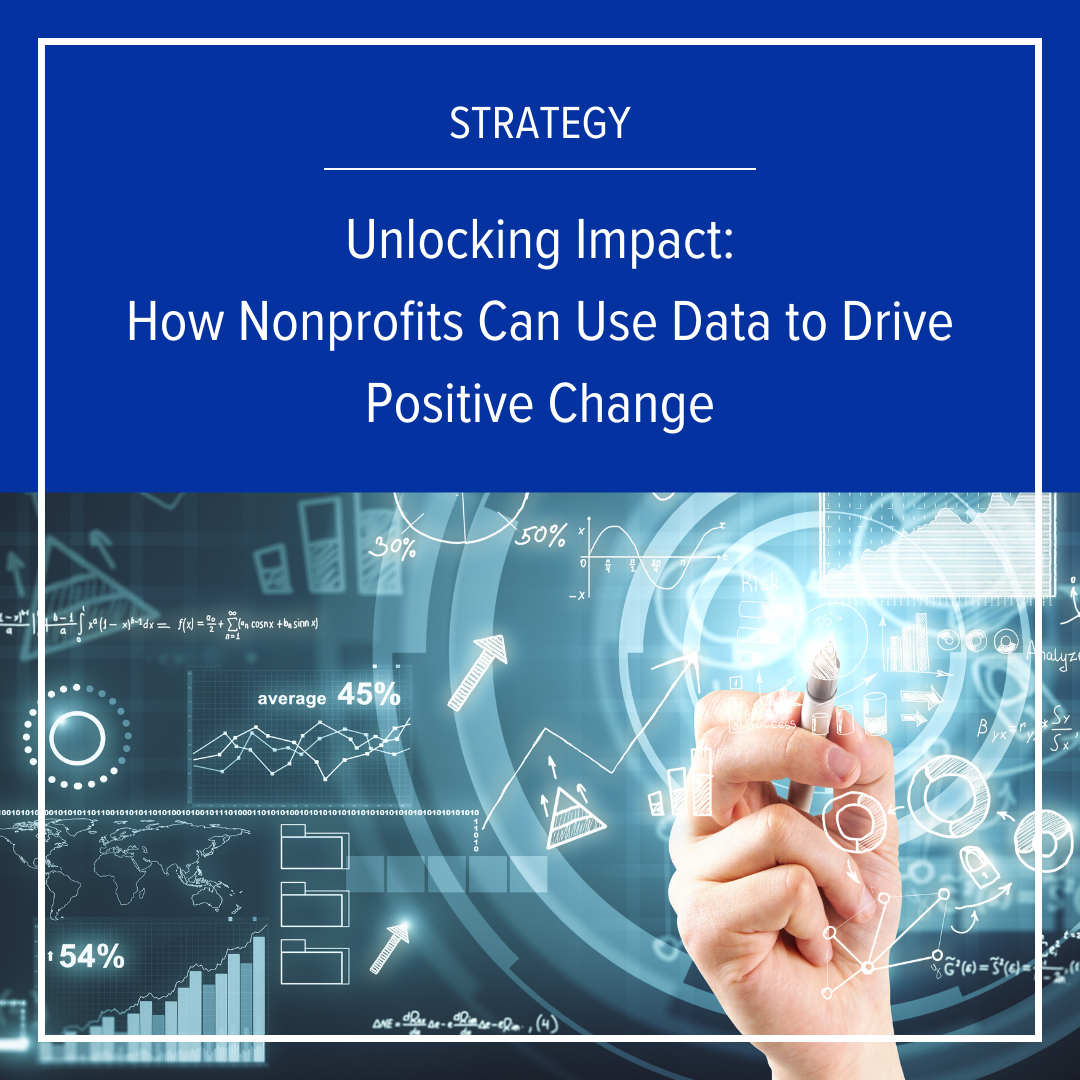
INSIGHTS

Partnerships Aren't Perfect: How to Overcome the Obstacles in Nonprofit Partnerships
While strategic partnerships offer numerous benefits to nonprofits, the process of forming them can be daunting due to perceived hurdles such as identifying the right partner, creating agreements, and managing the collaboration. However, these challenges can be overcome with careful planning and execution.

Unlocking Impact: How Nonprofits Can Use Data to Drive Positive Change
Data is the fuel that propels effective decision-making, allowing nonprofit organizations to maximize their reach and achieve their missions more efficiently. This is why a data strategy is crucial - it empowers nonprofits to leverage their information to build a more impactful future. Data is a powerful tool, and in the hands of forward-thinking organizations, it can pave the way for a brighter future for both the organization and the communities it serves.

Embracing the Future: Strategic Planning for Nonprofit Sustainability
By embracing strategic planning and adapting to the ever-changing landscape, nonprofits can continue to deliver their vital services, address community needs, and make a lasting impact on the world. Strategic planning is not a one-time exercise; it is an ongoing process that requires continuous adaptation and refinement to ensure that nonprofits remain relevant, effective, and resilient in the face of challenges and opportunities.

Merger Messaging: A Strategic Approach to Communications Planning for Nonprofit Mergers
Nonprofit mergers in health and human services, associations, credit unions, and many other sectors can be complex and challenging, but they can also present significant opportunities for organizations to amplify their impact, enhance their efficiency, and serve their communities more effectively. However, for a merger to be successful, it is essential to have a strong communications plan in place. We have the steps you need to develop and implement a strong communications plan, to ensure that all stakeholders are informed about the merger, that any concerns are addressed, and that excitement and momentum are built for the new organization.

The Fundamentals of Feedback
We’ve all heard the adage “feedback is a gift.” While most nonprofit leaders would agree, providing constructive feedback is a skill not all managers have mastered. Many managers are so uncomfortable giving feedback, that they avoid difficult conversations altogether. And receiving constructive feedback gracefully is another skill set altogether.
But studies show that high performing individuals crave feedback. In order to develop and retain that talent, and compete in the war for talent, we have to create a culture of feedback within our organizations. This means teaching our staff how to give - and receive - feedback effectively.
In this post, we will explore the do’s and don’ts for giving and receiving feedback and how you can support a culture of feedback within your organization.

Capacity & Cost Savings Through Org Design
It is important nonprofit organizations remember to address ‘how we work’ before ‘how many of us are working’ in order to tackle capacity issues more effectively. Our nonprofit consultants recommend addressing the root cause of capacity issues to free up time and resources that can be used to achieve your nonprofit organization’s strategic goals. This will lead to improved performance, reduced costs, and increased efficiency.

The Secret to a Successful Nonprofit Merger
In recent years there has been a massive upswing in the number of nonprofit mergers and affiliations throughout the country. As a nonprofit consulting firm that has facilitated a number of merger transactions for our clients, we have seen firsthand the factors that contribute to deal success. A nonprofit merger or affiliation (M&A) is weighted heavily on the relationships that exist between two organizations. Meaning, the currency of a nonprofit deal is the relationship that exists between the two organizations, which means the progress of the deal will move at the speed of trust.

CEO’s Guide to Managing Capabilities and Complexity
In recent years the role of nonprofit CEO has become increasingly complex. Between managing large-scale turnaround, merger integration, reducing costs, and technology implementation, nonprofit leaders are challenged with issues that require innovative thinking and new approaches to managing.
In this article, we are going to provide insight into two areas of focus that go hand-in-hand to help CEOs achieve short and long-term goals.

So you have a DEIB strategy. What now?
Over the course of the last three years, many nonprofits have rightfully prioritized diversity, equity, and inclusion. But where do those initiatives stand today? Are organizations seeing the progress they hoped for? If you’ve seen some progress, but want to make sure your efforts don’t stall or if you aren’t seeing the engagement you hoped for, it might be time to regroup and make a new plan.

Understanding the Benefits and Potential Drawbacks of Mergers
Nonprofit mergers can provide organizations with the opportunity to achieve economies of scale, increase market share, and diversify their program or service offerings. However, there are also potential drawbacks such as cultural conflicts, financial risks, and regulatory hurdles that organizations need to consider as part of the merger process.

3 Themes Taking Us Into 2023
2022 continued to be a year of rapid change for our mission driven clients and for the health and human services, association, credit union, and higher education sectors they operate in.
As the major shifts in the landscape show no signs of slowing, our nonprofit consultants have identified three themes that have been the focus of 2022 that will carry over into 2023: nonprofit consolidation, succession planning, and enhancing board governance.

5 Reasons to Start Strategic Planning Today
With 2023 quickly approaching, many purpose-driven organizations may be thinking about designing new strategic plans to help ensure long-term sustainability and viability.
Whether you operate in health and human services, higher education, credit unions, or associations, our strategic planning consultants have 5 reasons for you to start strategic planning today.

The Top 3 Areas to Address when Transitioning from Strategic Planning to Implementation
The nonprofit strategic planning process is a time that unites leadership and teams to collaborate, innovate, and ultimately create a solid plan that will guide the organization into the future.
But what comes next?
When the planning process is complete, many nonprofits are left to wonder how to implement the plan and meet the goals that have been set forth. The enthusiasm begins to wane and is replaced with feelings of unease and uncertainly as bigger and more timely decisions must be made.
If you have felt this shift, then you are not alone. Our nonprofit consultants have recommended 3 areas to address when transitioning from strategic planning to implementation.

5 Nonprofit Strategic Planning Tips for Senior Leadership
A dynamic and effective nonprofit strategic plan is arguably one of the most integral parts of any organization’s viability and success in today’s landscape. Get 5 Tips from our nonprofit consultants to make your strategic planning project a success.

4 Steps for Taking On Technology Today!
Complexity is a word that today's nonprofits are all too familiar with and the manner in which leaders address it can mean the difference between success and failure.
What is making the difference for many leaders and giving them the competitive edge, is the understanding, adoption, and implementation of improved and scalable technology solutions.
However, the adoption of new technology and digitalization can be a culture shift for many nonprofit organizations. The multitude of options, new terminology, and projected costs can - at times - make it feel as though it would be easier to maintain the status quo. For new systems to be successful, it requires an organization-wide commitment to learning, exploration, and buy-in. This begins with senior leadership making a commitment to the change.
